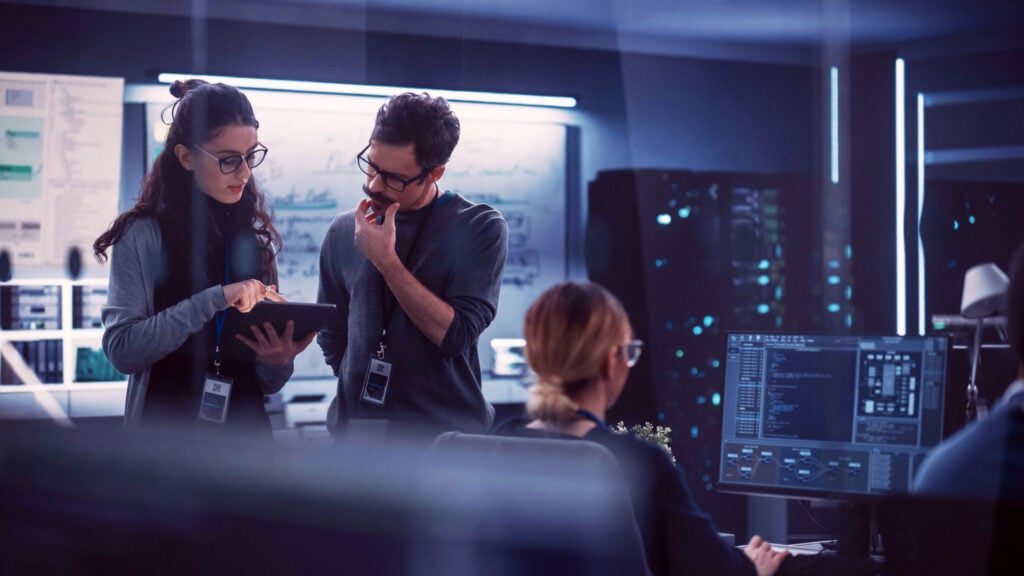Blog
Data is gold – protect it
By using new technologies in our everyday lives, enormous amounts of data are produced. 59 zettabytes of data were produced in 2020 in comparison to 2 zettabytes a decade ago. it is estimated that in 2021 this number will increase by 25%.

Your IT security may not look like it did yesterday
Do you remember?
All employees, sat in an office, with access to applications in a local data center that was like a solid castle protected by firewalls. The only way to access it was through the office. The security was stable and fulfilled its function. The company’s most important applications were located locally in secure data centers which worked flawlessly. However, the need to work from places other than the office was rather limited.
Today, reality looks rather different. In a modern business, a large proportion of their traffic goes to the Internet. This is because companies want to be able to use applications that are available as services in the cloud and because their users both need and want to be able to work anywhere at any time. According to a survey conducted by Gartner, 82% of business leaders expressed plans to let employees work externally.
But with users and applications in the cloud, it is not just business benefits that the company receives – in many cases, they also lose control of their customers, their users, and ultimately their data. In this guide, we describe the different types of security threats involved and what you can do to protect your business data, applications, and your users – regardless of time or place.
Having your head in the clouds does not always have to be negative
Today, your users have different behaviors than they had just a few years ago. Companies have spent astronomical sums on protecting their offices, but today it has lost some of its value. The office is no longer the priority.
Today it is solely about protecting the user. Security follows the client and the user,
no matter where they are. Something that turned out to be a sudden awakening for many companies when they realized this year that they have had to solve this problem.
Cloud-based users need cloud-based security
To become a company that gives itself a serious chance to protect its data, security must be built around the mobile user and applications in the cloud – not around the company’s office network. To perform their work in the best possible way, today’s users need effective access to the company’s applications.
For the company, this means that the client, transmission, and application must be secured when resources are moved from the local data center to public cloud services. So, what do you do to gain the visibility and control needed to protect your company’s data, clients, and users? This is done with a cloud-based security platform.
With users and clients that are largely connected to the Internet, companies need help and tools that respond to clients’ DNS lookups. With a security platform that analyses billions of DNS lookups daily, a better insight and overview of traffic activities and potentially harmful DNS lookups is achieved.
For companies, this means that they can easily and effectively analyze deviations, detect new threats, and monitor harmful traffic trends and behaviors. It enables companies to secure communication and connection no matter where the user is.
Implementing such a solution in the company is simple – by pointing the company’s external DNS to the cloud-based security platform, it will automatically check all pages that the user is trying to reach to see if they are malicious or not. If the page the user is trying to reach, is malicious, the security platform will block access.
Protect mobile users and secure their identity
As the modern workplace and its applications have moved outside the four walls of the office, the company has more and more clients in circulation. Tablets, mobile devices, and computers are common work tools for business employees. These are often also a potential path for attackers who want access to sensitive information.

To protect the company’s data, applications, and users, it is important to secure the identity of the person trying to access, so that they do not gain access with the use of username and password. This can be made possible with a cloud-delivered multifactor authentication.
Using a password is not new – nor is it new that it is simply not enough protection alone. To enjoy powerful and more secure authentication, and additional factors beyond the traditional password must be included when logging into critical applications, data, and systems.
However, similarly to traditional passwords, multifactor authentication is not new either. Usually, it works by entering your password followed by receiving an SMS with a code that you proceed to enter. A process that is neither smooth nor easy. In addition, it is difficult to make it work across many different cloud-based applications.
To avoid the problem of having to manually enter codes provided via SMS, it is a good idea to use a cloud-based multifactor authentication that automatically sends a push message to the user’s mobile when trying to access.
In this way, the user can easily confirm his identity with a single click. From a user’s perspective, this is an easy and user-friendly feature. From a business perspective, it is extra security. As the service can be used on both local resources and cloud services and can be tailored to each individual application, security is achieved that extends further and wider than traditional methods.
Another layer of security comes in the form of device control. By simply adding features that ensure that the user’s device or operating system is approved by the company, a security level is created that spans both user and device – without being too intrusive or extreme.
You never know what’s hiding in the shadows
With endless possibilities in the cloud, there are also endless possibilities for attackers, threats, and errors. Users can often feel compelled to take alternative paths with cloud applications that they know can help them perform their work in the best possible way.
In this way, there is a risk that Shadow IT will occur – things that happen outside the company’s control. In other words, to take control of the company’s data, applications and users, solid cloud-based security protection is needed to:

About the author

Lars Cederholm
CCIE
CCIE – with more than 25 years of experience in helping various types ofbusinesses to design, implement, and manage modern solutions innetworks and security areas that are tailored to the needs of the end-user.Lars’ focus right now is on developing and delivering the best modern cloud-based delivery for businesses with a cloud-first strategy and a […]
Related











